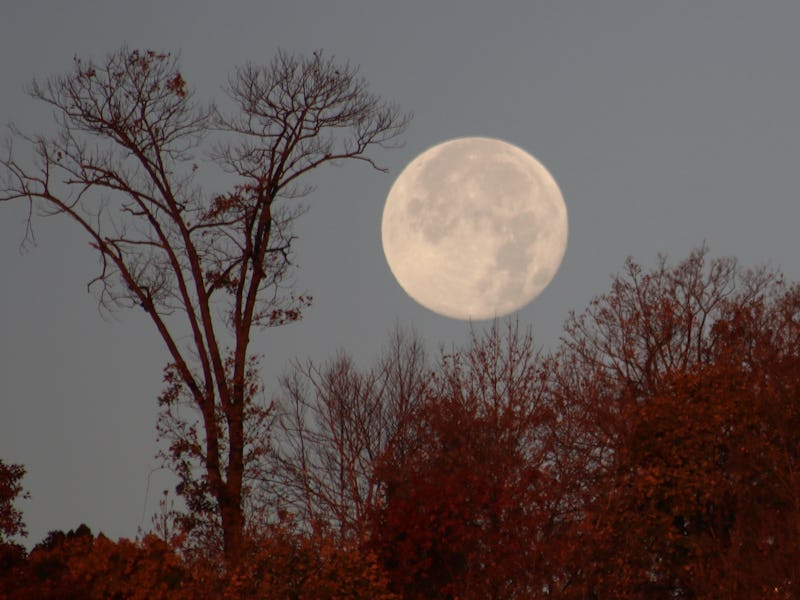You Cannot Miss Tonight’s Spectacular Beaver Moon — Here’s the Best Way To View It
‘Go look at the sky’ is the new ‘Go touch grass,’ and it’s very worth it.

November’s full Moon is here, and it’s the Beaver Moon!
The 2023 full Beaver Moon rises tonight and sets early tomorrow morning. Here’s everything you need to know to see this month’s full Moon (with a special guest appearance from Jupiter), including why it’s called the Beaver Moon, and what to expect from next year’s full Moon lineup.
How to See the 2023 Full Beaver Moon
The Beaver Moon rises shortly before sunset today. While the full Moon is low in the eastern sky, an optical illusion will make it look much larger than usual, but it will also look like a dim ghost of itself compared with the bright daytime sky. The result is an ethereal sight that’s well worth taking the time to see.
After sunset, the full Beaver Moon will shine brilliantly against the dark night sky. Look above the Moon and to its right for the bright gleam of Jupiter; our Solar System’s biggest and best planet should still be easy to spot after its recent opposition earlier this month. If you have a small telescope or a good set of binoculars, this is a great time to explore the lunar surface; look near the edges of the Moon to see mountains and craters in stark relief.
Tomorrow morning’s sunrise will turn the Moon into a faint ghost again just before it sets. If you miss the Beaver Moon tonight, it will still look very close to full on Tuesday before it starts waning toward the dark New Moon, which will rise on December 12.
Why is November’s full Moon called the Beaver Moon?
According to the Old Farmer’s Almanac, the Beaver Moon marks the time of year when beavers have finished storing food and retreat to their lodges for the winter. This is also the time of year when beaver pelts are at their thickest, and until the mid-1800s, that meant it was prime trapping season for fur traders.
Other North American Indigenous peoples have their own names for this month’s full Moon, also based on how the rhythms of the natural world reflect the changing of seasons. The Cree of what’s now Canada and the far northern U.S. and the Assiniboine of the northern Great Plains call this the Frost Moon, while the Anishinaabe of the Great Lakes region call it the Freezing Moon. (It’s easy to see why.) The Algonquin of what’s now eastern Canada call this the Whitefish Moon because it marks the time when whitefish begin to spawn. And the Tlingit of the northwest coast call it the Digging Moon because so many animals are digging — small ones to forage, and bears to build their dens.
Here’s some food for thought: What do the Indigenous people in your area call the month’s full Moon? Why? If you were naming November’s full Moon after something that marks the current season in your culture, what would you call it? This is an interesting way to consider how your own cultural relationship with this season is different from — and similar to — that of other cultures.
Have you seen a beaver kit today? Now you have. This is three-month-old Momo, who was found alone on a dike after a 2013 flood in Germany.
This is some Dam Cool Beaver Trivia
In honor of this month’s Beaver Moon, sink your teeth into these beaver facts:
Beaver dams create wetlands, which provide good habitat for many species of frogs, fish, turtles, and insects.
Beavers recognize their relatives based on their anal gland secretions.
Beavers start repairing their dams when they hear the sound of running water.
Eurasian beavers sometimes defend their territory by holding up a stick and bouncing up and down in shallow water.
In a Cree myth, a beaver dam caused a flood that covered the entire world.
2024 Full Moon Forecast
For the next couple of weeks, as the side of the Moon facing Earth turns away from the Sun, we’ll see a gradually shrinking slice of Moon in the night sky, until the almost-invisible new Moon on December 12. From there, the Moon will start appearing to grow again as it turns back toward the Sun, culminating in December’s full Moon: the Cold Moon on December 26.
We’ll see 12 full Moons in 2024 — one per month. We won’t see another Blue Moon until May 31, 2026 (a Blue Moon happens when two full Moons appear in the same month, and the last one was August 31, 2023). But next year will feature three supermoons (a supermoon happens when the Moon is slightly closer to Earth than usual during a full Moon) on February 9, March 10, and April 18.